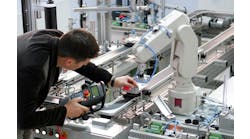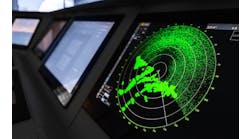So you’ve got a machine that is going to make parts for you. You know the basic design and you have selected a programmable logic controller (PLC), human-machine interface (HMI) and some drives and pneumatic devices to operate the machine. You’re feeling pretty good about where the design is going, but now it is time to get down to details.
One of the defining moments in the design of a control system comes when we decide which sensors to use for the various devices that make up the machine or process. What are the best sensors to use? The answer is all of them. While this seems like a simple answer, the explanation is far more complicated.
The choice of a sensor is absolutely dependent on the object being detected and what you are hoping to learn about that object. Is it stationary? Is it in motion? Do we need to know how fast? For the purposes of this dive into control design, let’s focus on presence sensing.
Even focusing on just the presence of an object doesn’t really narrow the field by very much at all. The size of the object, distance from it and environment in which the sensing will occur will determine what type of sensor we will choose. Generally, we can break presence sensing down into three main groups: proximity, photo-optics and ultrasonic.
Proximity sensors, as the name implies, detect the proximity of the object to the sensor. These are a non-contact method of detecting an object, and, because there is no physical contact, these sensors work well in harsh environments.
There are three types of proximity sensors—magnetic, capacitive and inductive. The names imply the method of detection.
Magnetic proximity sensors detect the presence of an object with magnetic properties. An example of this would be a pneumatic or hydraulic cylinder where the moving plate to which the cylinder rod is connected, is a magnet. A sensor, often called a reed switch, activates in the presence of a magnetic field. The principle is based on the properties of a magnet where opposites poles attract and similar repel.
The “fingers” of the reed switch are ferro-magnetic and situated very close to each other. In the presence of a magnet, the blades pull toward one another to complete an electrical circuit—close the switch. The downside of a magnetic switch is the object and switch must be very close to each other for it to work.
Capacitive proximity sensors simply measure a change in capacity. The sensor has capacitive plates in the head. As the object approaches, the nominal capacitance between the plates in the sensor will change and that change triggers a change in state of the switch contained in the sensor.
For this reason, a capacitive sensor can really detect any object but is dependent on the size of the sensor and the size of the object to determine how far away from the sensor head, the object can be detected.
An example of the use of a capacitive sensor is to detect an object inside a carton or box. The sensor is calibrated to ignore the simple presence of the carton, so that something inside the carton, like a pouch with powder in it, will cause an increase in capacitance and trigger the sensor. This makes the capacitive sensor a good choice for detecting non-ferrous objects. Again, the size of the sensor and the object will determine the sensing distance.
Inductive proximity sensors detect ferrous objects. A magnetic field is generated from a coil in the sensor head.
Eddy currents will be generated by the approach of a metallic object. Changes in impedance due to those eddy currents will trigger the sensor and change state. The size of the metallic object and the magnetic properties for that specific metal will determine the sensing distance of that particular object.
Capacitive and inductive proximity sensors can be limited in the detection field to increase the accuracy of the detection point by shielding the sensor. Generally, this is done by increasing the metallic sides on the sensor to narrow down the field that is generated by the sensor.
Picture a non-shielded sensor as emitting a field that is mushroom-shaped in appearance. The exact center of the sensor head would have the greatest range of detection and the outer edges of the center, with some wrap around to the sides, would be the least range.
To increase the accuracy of the sensor, shields force the detection field away from the edges of the sensor. While this also limits the field at the dead center of the sensor, it also weakens the field away from the center to the point where only the very center of the sensor will be an effective detection field.
Larger diameter sensors will have a larger sensing region where smaller diameters will have a far smaller sensing region. Where accuracy is critical, use a small diameter sensor.
Keep in mind that capacitive and inductive sensors are intended to be non-contact. Direct contact with either sensor will damage the surface of the sensor, diminishing the capability of the sensor to correctly sense the object. It is also good to note that mounting the sensor perpendicular to the direction of travel of the object will help protect the head of the sensor from accidental contact and will also enhance the accuracy of sensing.
Ultrasonic sensors are also non-contact but rely on the sensor producing a sonic—sound—wave and measuring the time required to get the reflected pulse back to determine where the object is.
A good example of where this might be used is in a grain or flour bin/silo. The sensor is mounted up near the top of the bin and projects a sonic beam down into the main body of the receiver and the reflected beam will change as the vessel fills and empties. The result can be used to turn on digital points related to “full” or “empty” or can be used as an analog value to indicate the relative level in the bin.
The same sensor could be applied in free space to indicate the approach of an object, like a fork truck or car. Accuracy is good, and many different objects can be sensed as it is dependent only on a reflected or transmitted wave. Object material, surface or texture do not impact the sensing ability.
Photo-optic sensors, generally, fill the space between close proximity situations—inductive, magnetic and capacitive—and the longer-range ultrasonic situations. However, optical sensors can also be applied to both close and long-range sensing, as well.
Photoelectric sensors consist primarily of an emitter to transmit light and receiver to receive that light. The emitter and receiver may be contained in the same physical package or be two separate devices. The application can be defined as through-beam, where emitter and receiver are separate devices that point at each other; retro-reflective, where the emitter and receiver are in the same package and a reflector is used to bounce the emitted beam back at the source; and diffuse-reflective, where the object itself is used to direct the emitted beam back at the receiver. The choice of which type of photoeye to use depends on the application and the object to be detected.
Through-beam sensors, as the name implies, are set up where the emitter and receiver units are mounted such that they oppose each other. It is critical to align the face of each so that the beam from the emitter is “caught” by the receiving unit.
When an object breaks the beam of light between the pair of devices, the receiver changes state to indicate the presence of an object. By default, the switch is on until the beam is broken.
This can cause some confusion to the programmer because the off state of the sensor will indicate the presence of the object. However, this also presents a good failsafe as a broken sensor will also present as off and can be monitored in the programming to capture the broken wire/sensor condition. Through-beam sensors are good for long distances—3 ft or more—so can be applied to larger object detection applications.
Retro-reflective sensors have the emitter and receiver in the same package and use a reflector to bounce the beam back at the receiver. In a normal state, the emitted beam bounces back to the receiver.
The presence of an object between the sensor and the reflector will result in a change of state in the sensor. The risk with this type of sensing application is the object itself may have reflective properties and bounce the emitted beam back at the receiver, even though the object is in the beam path. A through-beam would be better for this application.
To help with limiting random reflected beams, a polarized reflector can be used to deflect most random light sources and only bounce the emitted beam back at the receiver in the sensor.
Diffuse-reflective sensors use the object itself to bounce the emitted beam back at the receiver. The absence of the object means the emitted beam just passes off into infinity—not really, but it won’t be bounced back. With the object in the beam path, a portion of the emitted beam will get back to the receiver, satisfying the sensing state and turning the sensor on.
Many conditions can affect both retro-reflective and, especially, diffuse photoeyes. The contour and surface properties of the object may limit the ability of the emitted beam to get back to the receiver. The light source may limit the reflected beam. White light is easily deflected, whereas red or infrared spectrum is more directional and appropriate for this type of sensing. The color of the object will also impact the reflected beam. Some colors of the object will absorb the transmitted light while others will reflect it well. For this reason, multiple light source colors are also available. Some sensors even have multiple light sources in the same sensor packages and can be taught to determine the best light color for the object color. Laser light sources can be used to adapt to surface properties of objects to pick up bumpy surfaces, as well. The end goal is to make the sensor come on and stay on for the full exposure of the object without flickering off and on.
Different applications call for different sensors for presence sensing of objects. Knowledge of the properties of the various devices and experience are the best tools for making the correct decision.





